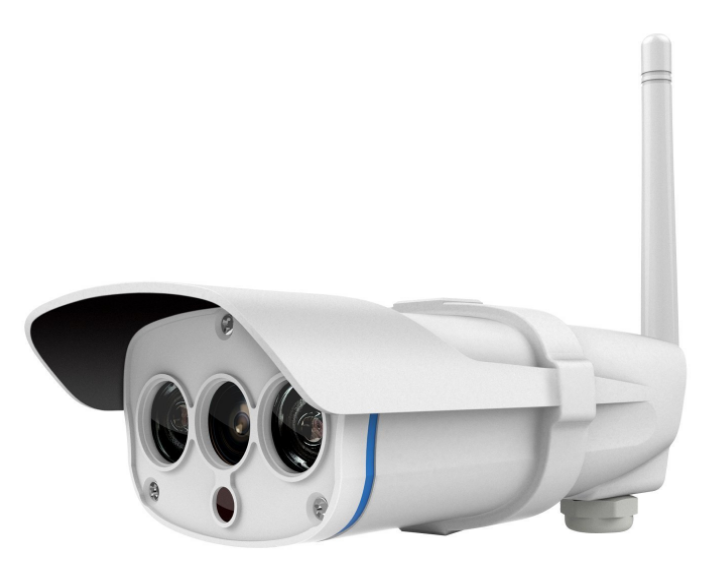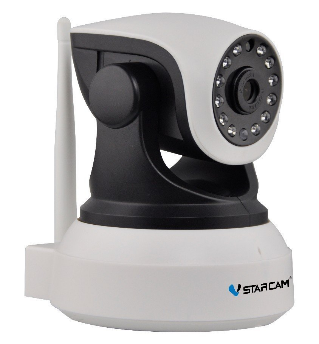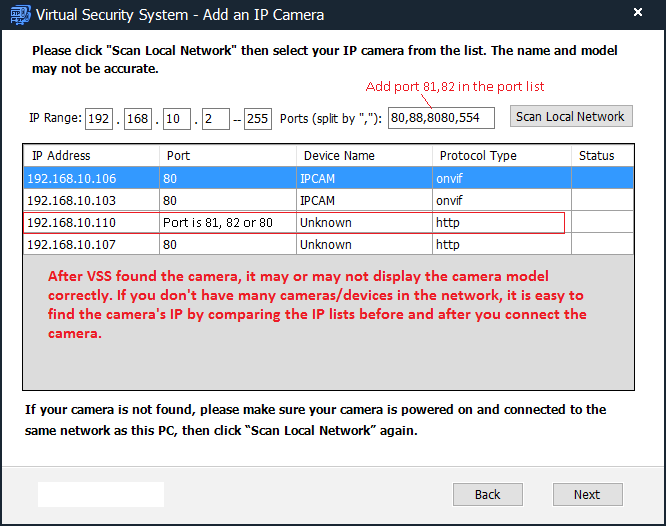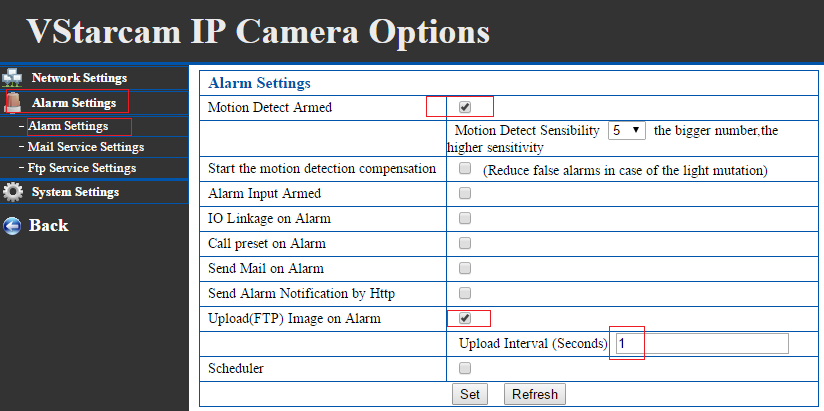Configure Vstarcam Network Cameras for Cloud Recording, Remote Monitoring and Playback
Contents
Step 1: Connect camera to the network and find its IP address
Step 2. Access Camera's Web-based Configuration Tool
Step 3. Configure video profile
Step 5. Configure Events (Motion Detection and Snapshots)
5.1 Configure Motion Detection
5.2 Configure Image Snapshot Settings
We have not fully tested Vstarcam cameras. Based on user feedback, Vstarcam Cameras are more or less compatible with CameraFTP cloud recording service. The cameras can upload image snapshots to our FTP server for both motion-triggered or continuous cloud recording. Vstarcam has indoor and outdoor cameras. Motion detection is also supported. With the help of CameraFTP VSS software running on a PC, it can upload video clips to the cloud.

VSTARCAM C7816WIP HD720 WiFi camera |
 VSTARCAM C7824WIP HD720P PTZ camera |
Basic camera information
| Video / image resolution | 1280x720 and 1920x1080(?) |
| Audio recording | Outdoor: No; Indoor: yes(?) |
| Image upload frequency | Camera dependent: 1 image/1s or 1 image/10s(?) |
| Video frame rate | 1-30 |
| Night-vision | Outdoor models up to 100 feet(?) |
| Image snapshot recording | Supported |
| Video clip recording | Not Supported (Support with CameraFTP VSS) |
| Motion detection | Supported |
| Continuous recording | Yes |
| Supported video format | N/A (.mp4 with CameraFTP VSS) |
| Connection type | Ethernet cable and Wi-Fi |
| PoE (Power on Ethernet) | Some models |
| Indoor / outdoor | some models |
| Lowest pricing (as of 7/1/2016) | N/A |
Note: This document is not designed to replace the product manual from the manufacturer. The information provided is based on our customer feedback of certain model Vstarcam cameras. It may not be accurate or up-to-date. Users shall contact the manufacturer for all camera-related issues and contact us only for CameraFTP-related (cloud service / FTP) issues.
The first two steps are camera related and are very trivial. If you have finished these basic steps, you can skip Steps 1 and 2.
Step 1: Connect the camera to the network and find its IP address
Follow the instructions to connect your camera. Then run the Setup / IP Search program from the manufacturer to find the camera's IP address.
If you cannot find the setup / IP search program, you can also install CameraFTP VSS to find the camera.

After you find the camera's IP address, you can launch Microsoft Internet Explorer (it does not work with other web browsers) to access the
camera’s configuration site
http://IP_ADDRESS:PORT/ (For example: http://192.168.1.101:81/ )
Step 2. Access the Camera's Web-based Configuration Tool
Log on to the camera with the default username: admin, and the password is blank (none). It is recommended to change the password. If you are prompted to install ActiveX/plugin, please install it. After successful logon, it will go to the live-view screen or the setup main screen
You can then click System Settings to access the camera's configuration pages. The CameraFTP service setup is only dependent on a few parameters. You can quickly check the setup options to see if you need to configure anything.
Step 3. Configure the video profile
Dependent on the camera model, it might have an option to set video / image profile. Please set the video size, frame rate based on generic video camera setup guide. You can ignore this section if it does not have such options.
If you want to use VSS for video recording, then the parameters are dependent on your subscription level. Please note: The CBR (constant bit rate) must be changed. The default bit rate is designed for local network only. Setting it too high will slow down your network connection and causing upload to fail. Please also make sure your Internet connection has enough upload bandwidth. (ADSL type of connection is usually too slow, you might need to set the bit rate even lower.) Assuming you have enough upload bandwidth, you can set the maximum bit rate based on the bandwidth calculator. (Visit www.cameraftp.com, click on Pricing, and then customize a plan)
Step 4. Configure FTP Settings
Click Alarm Settings --> FTP Service Settings, you will see the screen:

You need to set the following parameters:
- FTP Server: ftp.cameraftp.com or 66.220.9.45
- FTP Port: 21
- Username and password: Your CameraFTP username; and the camera license key as the password. You need to add a camera from www.cameraftp.com website first.
- FTP Mode: PASV
- FTP Upload Folder: Your Camera Name (you need to add a camera on www.CameraFTP.com website)
Step 5. Configure Alarm (Motion Detection and Snapshots)
5.1 Configure Motion Detection
If you ordered a plan with motion detection enabled, then you must configure motion detection with your camera. Click Alarm Settings --> Alarm Settings, you will see:

Check "Motion Detect Alarmed" and "Upload (FTP) Image on Alarm, set a motion detect sensitivity level; The "Upload Interval" should be set based on your service plan. If you ordered a plan with 1 image per 3 seconds, then the duration should be set to 3.
If it supports Motion Detect Area, then please set a motion detection area.
Click Set to save the settings.
5.2 Configure Continuous Image Snapshot Recording
This camera can only upload image snapshots and not video clips. It is ok as CameraFTP has viewer apps that can play the recorded image snapshots just like video clips. If you ordered a video plan, you need to: (1) order a new image plan and cancel the old video plan; or (2) Run CameraFTP VSS on a PC. Do not configure FTP in the camera. VSS can upload video clips to CameraFTP.
It is unclear whether this camera supports continuous image recording. If it does, we are not sure if you can configure the upload frequency. It seems you can enable continuous recording in the FTP Settings screen by checking the checkbox of "Upload Image Now". You will need to check the upload frequency, and then order a subscription plan to match the upload frequency. Motion recording will be a better option for this camera model.
6. CameraFTP Viewer
You are all done. For safety, you can reboot the camera to make sure it still works fine. If you need to make changes, you can run the setup program again to find the camera’s IP address (as it may change with DHCP), and then access the camera’s Configuration pages.
After your camera is setup, you canv visit www.cameraftp.com to monitor or play back your recorded footage from anywhere. You can also download CameraFTP Viewer App for iOS and Android.
Note: Currently Vstarcam cameras cannot upload video clips to FTP server directly. To upload video clips, you can use CameraFTP VSS on a PC. These cameras probably is compatible with VSS-based Live View, Cloud Recording and Local Recording.
If you use VSS for video recording, it is important to set the correct video size, frame rate and bit rate in Video Profile Settings.
Cannot get it to work? Please read our Trouble-shooting Guide.
